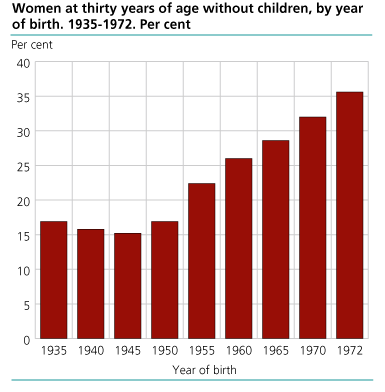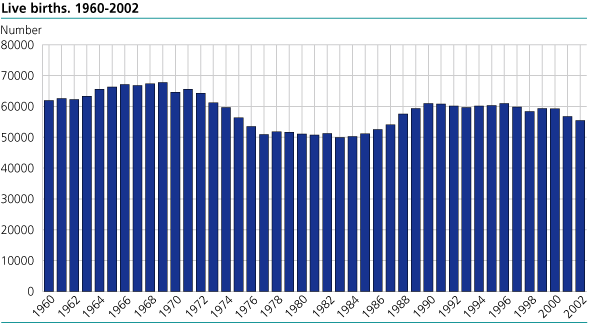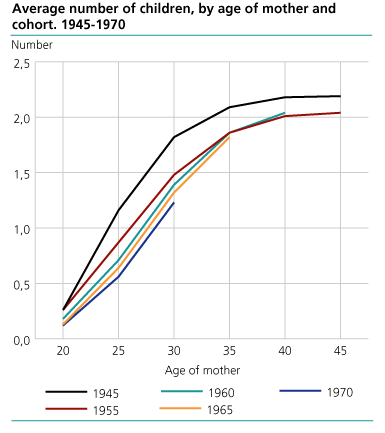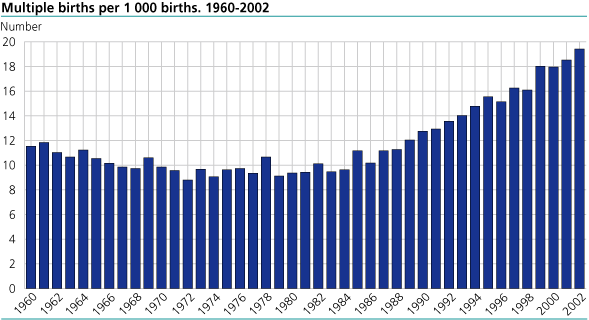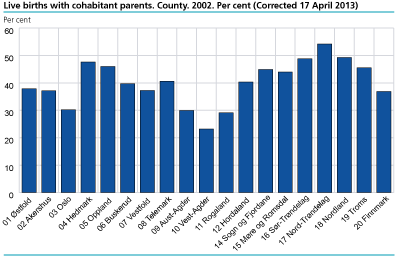Content
Published:
This is an archived release.
Every third woman without children at 30
In 2002 more than one out of three women had not yet given birth at the age of 30. Twenty years ago, one out of six women had not given birth when they turned 30 years. There has been an increase in the numbers of women giving births in their thirties, and fewer give birth before 25 years of age.
Approximately 55 400 children were born in 2002, 1250 fewer than in 2001. The number of births from last year was lower than those for the 1990s. In the 1990, the numbers of live births varied between 58 400 at its lowest and 60 900 as its highest. The decrease in the number of births is partly a result of fewer women in reproductive age.
1.75 children per woman
The total fertility rate was in 2002 1.75 children per woman. In 2002 and was slightly lower than for the two previous years. It is too early to say if the decline is a new trend, or if it is due to random circumstances. There has been a decrease in first births, second births and later births, but the decrease has been the largest among the third- and fourth births.
When we look at the birth cohorts for women, who have past 40 years, all of them have given birth to more children than estimated by the total fertility rate. Women born in 1962 had at the age of 40 on an average given birth to 2,04 children.
Highest fertility in Sogn and Fjorande
Sogn and Fjorande had the highest fertility with a total of 1.97 children per woman, while Vestfold had the lowest rate with 1.60 children per woman. It is mainly the costal counties from Vest-Agder and northwards that have a total fertility rate above the average for Norway as a total. Aust-Agder, the counties in south-east Norway and those in the inland had a total fertility rate below the national average. One exception was Akershus, which for the first time had a total fertility rate above the country's average in 2002.
In 2002, most of the counties had a decline in the total fertility rate. Only Finmark, Akershus and Østfold had an increase in the total fertility rate from 2001. The highest increase found place in Finnmark with and increase from 1.85 to 1.95. Møre og Romsdal experienced the largest decrease from 1.98 in 2001 to 1.86 in 2002.
First time mothers were 27.7 years old
Women, who became mothers for the first time in 2002, were on average 27.7 years old - 0,2 years older than the previous year. The average age for all mothers in 2002 was 29.9 years for mothers and 32.8 years for fathers.
In both absolute and relative terms, most births took place in July and fewest in December.
Increase in the numbers of multiple births
In 2002 the number of twin births amounted to 1044 and triple births totalled 15, adding up to 19.4 multiple births per. 1000 births. 25 years ago - in 1977 - the proportion of multiple births was 9.4. From the beginning of the 1970's until 2002, the proportion of multiple births has increased steadily.
58 per cent of the children born in Nord-Trøndelag had cohabitating parents
42 per cent of the children born in 2002 had parents living in cohabitation, 49 per cent had married parents and 9 per cent had a single mother. When we look at the respective counties, Nord-Trøndelag and Nordland had the highest proportion of cohabitating parents, 58 and 55 per cent respectively. Aust-Agder had the lowest proportion of cohabitating parents, 27 per cent.
Tables:
- Table 1 Live births and late foetal deaths. 1951-2002
- Table 2 Live births, by month. 1971-2002
- Table 3 Confinements of single and multiple births. 1956-2002
- Table 4 Confinements of single and multiple births, by sex. 1991-2002
- Table 5 Age-specific fertility rates and total fertility rate. 1961-2002
- Table 6 Average age at birth. 1946-2002
- Table 7 Mean age of parents at all births, by county. 2002
- Table 8 Total fertility rate, by county. 1968-2002
- Table 9 Live births, by parity. 1978-2002
- Table 10 Live births, by municipality and county. 2002
- Table 11 Live births, by cohabitation status and county. 2001 and 2002
- Table 12 Live births, by parity, cohabitation status and county. 2002
- Table 13 Mean age of mother and father and cohabitation status at birth of the child, by county. 2002
- Table 14 Number of children distributed, by age and cohort. Per cent
Contact
-
Statistics Norway's Information Centre
E-mail: informasjon@ssb.no
tel.: (+47) 21 09 46 42
-
Espen Andersen
E-mail: espen.andersen@ssb.no
tel.: (+47) 92 61 00 46
-
Ane Margrete Tømmerås
E-mail: ane.tommeras@ssb.no
tel.: (+47) 91 99 29 62
-
Oppdrag befolkningsstatistikk
E-mail: befolkning@ssb.no

